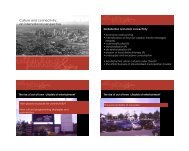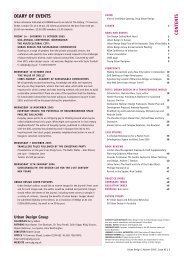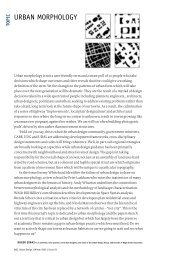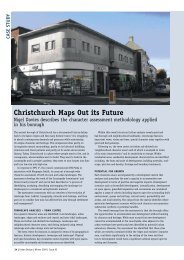CONTENTS DIARY OF EVENTS - The Urban Design Group
CONTENTS DIARY OF EVENTS - The Urban Design Group
CONTENTS DIARY OF EVENTS - The Urban Design Group
Create successful ePaper yourself
Turn your PDF publications into a flip-book with our unique Google optimized e-Paper software.
QUALITY HOUSING: THE CRUCIAL ROLE <strong>OF</strong> THE<br />
LOCAL AUTHORITY<br />
Roger Estop wonders how, given CABE’s recent audit that showed<br />
housing quality is directly related to local authority involvement, can<br />
local councils deal with both quality and growth<br />
For the ODPM and the house building industry, the delivery<br />
of ‘sustainable communities’ means numbers of units<br />
appearing on the programme. This measure dominates policy<br />
and implementation work in the South and East of Britain.<br />
However, it falls to the local authorities, with or without<br />
delivery companies, to conjure up these communities through<br />
the planning system, and adopt and steward them long after<br />
the ODPM has met its targets and the developers have left.<br />
Embedding urban design into the local planning process is vital<br />
to getting a physical structure and character that makes a place<br />
home when the people move in.<br />
LOCAL AUTHORITY INTERVENTIONS<br />
CABE’s housing audit: assessing the quality of new homes<br />
(October 2004) shows that house builders sometimes come<br />
up with good schemes, but generally produce rubbish. When<br />
they get it right there is a direct link to positive engagement<br />
with the local authority. While stressing that house builders<br />
and local authorities are jointly responsible for the quality of<br />
outcome, the CABE audit demonstrates that local authorities<br />
make a difference. <strong>The</strong>y can and do change developer practices,<br />
especially in combating the standard building type.<br />
So, how are major housing schemes improved by local<br />
authorities?<br />
• Firstly, the dedicated attention of individual planners, in<br />
tireless pursuit of making routes, spaces and perimeter blocks<br />
work - ensuring connectivity, continuity, containment of space,<br />
separation between public and private<br />
• Secondly, a good policy base and welloiled<br />
procedures for supplementary<br />
guidance, and<br />
• Thirdly, the vocal support of chief<br />
officer and members - a pro-design<br />
mindset in the organisation that sees<br />
design as problem solving, the route to<br />
sustainability, community and economic<br />
promotion.<br />
NOT PURELY DESIGN SKILLS<br />
Spatial understanding and visualising<br />
skills are key, but hands-on designing<br />
is not always necessary; scrutiny and<br />
challenge forces rigour in the design<br />
process. <strong>The</strong> key skills are those of the<br />
new vision development control planner<br />
combining a sense of strategic space and<br />
attention to detail. <strong>The</strong> key resource is<br />
time, and when these skills and resources<br />
are committed to major developments,<br />
places are better.<br />
What do you call the local authority<br />
function in relation to place-making?<br />
Not development control, that’s for sure<br />
- the term is too closely bound up with<br />
the bureaucratic awfulness of getting<br />
planning permission, and not associated<br />
Higgins Homes<br />
canalside development<br />
of apartments and B1<br />
accommodation, at<br />
160 dw/ha, designed<br />
following a planning<br />
brief that suggested a<br />
built form<br />
<strong>Urban</strong> <strong>Design</strong> | Spring 2005 | Issue 94 | 23<br />
TOPIC







